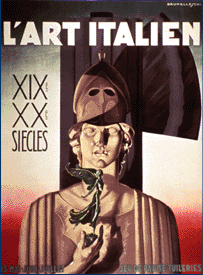
Poster, Italian Art of the 10th & 20th Centuries
Designed by U. Brunelleschi (Italy, 1879-1949)
Commercial color lithograph (61 x 46")
84.4.7
Mussolini began his Fascist party as a small revolutionary clique in 1919. It grew quickly. In 1922, Mussolini was appointed prime minister and by 1925, Italy had made the transition from a democratic to a totalitarian state, with Mussolini as its dictator. The new leader supported the production of a wide range of design objects to use in persuading the public to accept and support the Fascist’s programs. At first, many cheered his rule, seeing him as a strong leader who was capable of bringing order to the chaotic economic and political environment the country had experienced since World War I. However, his totalitarian government used extreme measures to limit personal freedoms and embroiled Italy in World War II on the side of Nazi Germany, and eventually lost favor.
Propaganda material, such as this poster, often used motifs and symbols inspired by classical Roman art. This practice was part of Romanità–the intense belief that Fascism was the continuation of the glorious Roman Empire. By referring to the power of the Roman civilization, the artist elevates not only the importance of Italy’s cultural heritage but also the legitimacy of Mussolini’s Fascist government. The central figure here depicts the Greek goddess Minerva, shown as the helmeted goddess of war. She is also presented in her second role as patroness of learning and the arts, indicated by the owl that adorns the helmet. Another ancient icon is placed behind Minerva–the fasces, a bundle of reeds tied together with an ax. Originally, the fasces was carried by Roman officials to signify their authority. In 1926 Mussolini adopted the fasces as the official emblem of his Fascist regime.
Back to Political Propaganda Main
Back to Collections Main